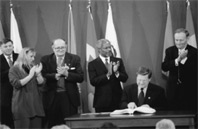In 2017 the Convention turned 20!
Two decades of partnership between governments and civil society to
“end the suffering caused by anti-personnel mines”
After several regional conferences and a worldwide campaign to bring awareness and support for a comprehensive humanitarian ban, negotiation began on 1 September 1997 in Oslo.
On 18 September, over 90 States agreed to adopt the Convention.
A little more than two months later, in December 1997, the so-called Ottawa Process culminated in the gathering of 122 States in the Canadian capital, for the signing the Anti-Personnel Mine Ban Convention.
To date, membership has grown to 162 countries undertaking to “never, under any circumstances, use anti-personnel mines; develop, produce, otherwise acquire, stockpile, retain or transfer to anyone, directly or indirectly, antipersonnel mines; assist, encourage or induce, in any way, anyone to engage in any [prohibited] activity.”
According to those close to the process, this was “an extraordinary accomplishment by almost any measure of what is considered to be success within international diplomacy.”
The Ottawa Process was a “bold gamble” that paid off largely as a result of the advocacy work of the International Campaign to Ban Landmines and the International Committee of the Red Cross working in partnership with a core group of States that were equally committed to a ban on anti-personnel mines.
The Ottawa Process
In addition to a variety of regional conferences and mine action forums that took place in 1997 all over the world, the Process featured the following events of great significance:
- 3-5 October 1996: International Strategy Conference: Towards a Global Ban on Anti-Personnel Mines, Ottawa, Canada
- 12-14 February 1997: First Expert Meeting on the Convention for a Prohibition of Anti-Personnel Mines, Vienna, Austria
- 24-25 April 1997: International Meeting of Experts on the Possible Verification of a Comprehensive Treaty Prohibiting Anti-Personnel Mines, Bonn, Germany
- 24-27 June 1997: International Conference for a Global Ban on Anti-Personnel Mines, Brussels, Belgium
- 1-18 September 1997: Diplomatic Conference on an International Total Ban on Anti-Personnel Mines, Oslo, Norway
- 2-4 December 1997: A Global Ban on Anti-Personnel Mines: Treaty Signing Conference and Mine Action Forum, Ottawa, Canada


